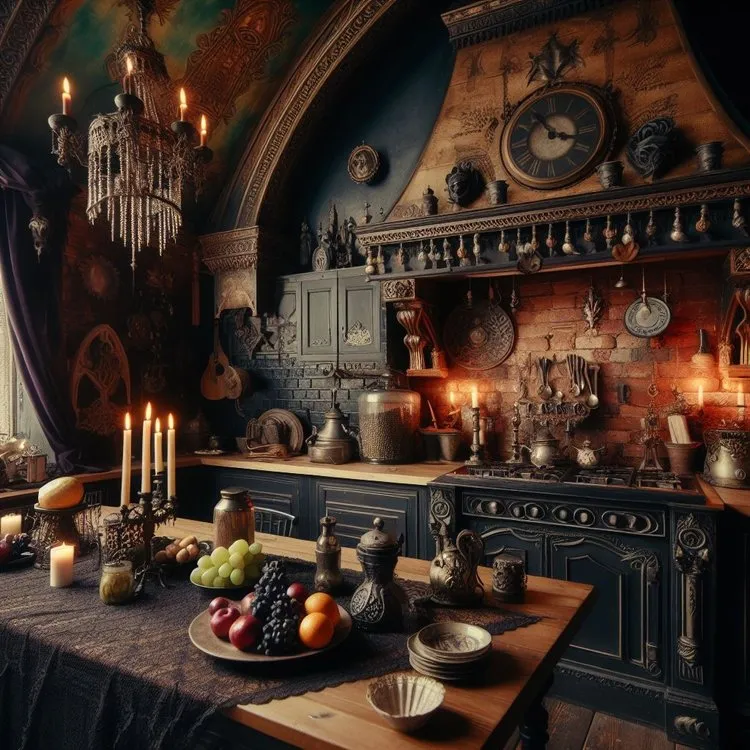What is Gothic Kitchen Decor?
Gothic kitchen decor embodies a style that merges the dark, mysterious, and dramatic elements of Gothic architecture and design with the functionality of a modern kitchen. It’s a bold statement, creating a space that is both visually captivating and highly personal. Unlike minimalist or brightly lit kitchens, a gothic kitchen embraces rich colors, intricate details, and a sense of historical grandeur. This style often incorporates dark wood, ornate hardware, dramatic lighting, and unique decorative accents to create a space that feels both elegant and slightly mysterious. The goal is to evoke a sense of history, depth, and a touch of the macabre, transforming the kitchen into a unique and unforgettable space. The aesthetic draws inspiration from the Gothic period (roughly 12th to 16th centuries), characterized by pointed arches, vaulted ceilings, and stained glass windows. These elements, when translated into a kitchen setting, result in a dramatic and atmospheric environment.
Origins and Inspiration
The origins of Gothic kitchen decor are deeply rooted in the Gothic architectural movement, which flourished in Europe during the medieval period. Gothic architecture is immediately recognizable by its distinctive features such as pointed arches, ribbed vaults, and flying buttresses. These elements were used to create soaring, light-filled spaces, particularly in cathedrals and churches. This architectural style emphasizes verticality, grandeur, and intricate detail, inspiring the kitchen design. The inspiration for Gothic kitchen decor comes from a desire to capture the essence of this historical period. It’s about bringing the drama, the artistry, and the sense of timelessness into the most functional space of your home. The design embraces rich colors, dramatic lighting, and ornate detailing. This approach can transform a kitchen into a visually striking and atmospheric environment, reflecting a profound appreciation for history and design.
Key Elements of Gothic Kitchen Design
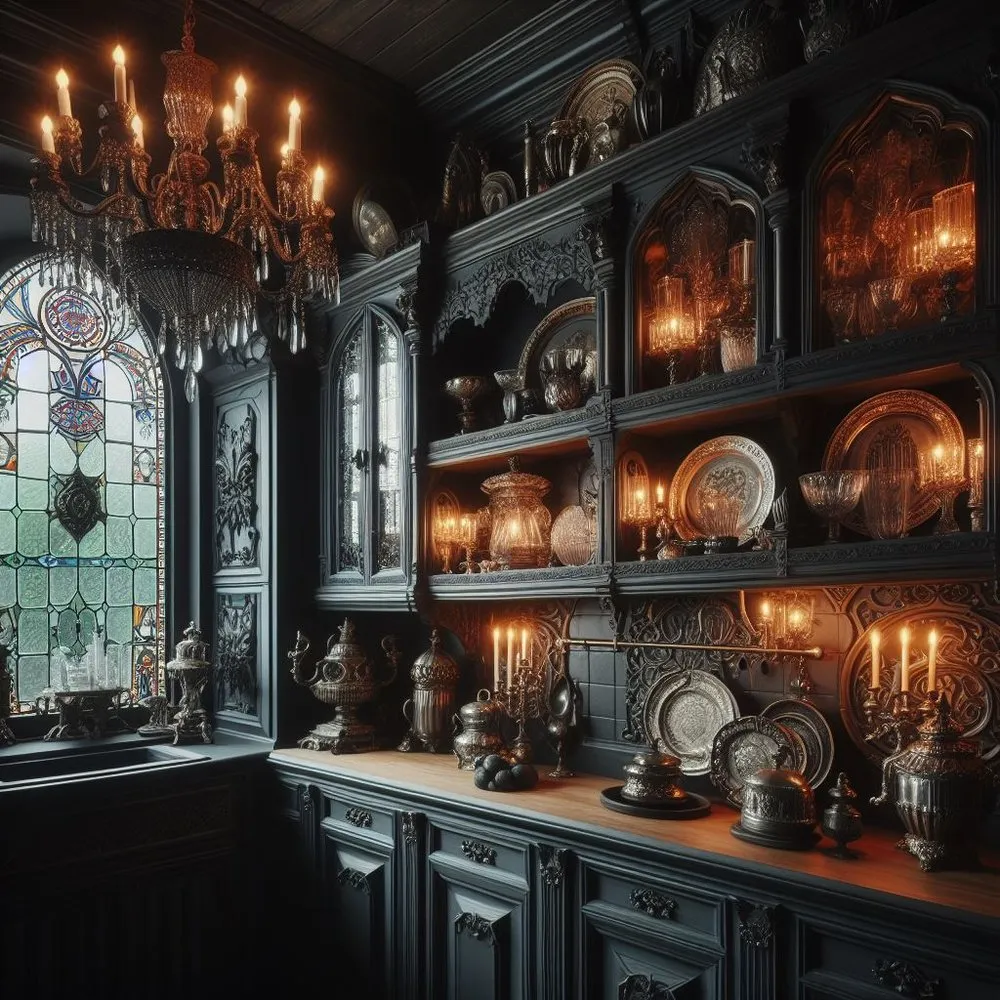
Several key elements define a Gothic kitchen, setting it apart from other design styles. The choice of materials, color palettes, and decorative accents all play vital roles in creating this unique aesthetic. Key elements include the use of dark, rich colors, often featuring deep reds, blacks, purples, and greens. These colors set the mood, creating a sense of depth and mystery. Another important element is the use of dark wood, either for cabinets, flooring, or furniture. Ornate hardware and fixtures, such as wrought iron handles and antique-style faucets, add intricate detail. Dramatic lighting, including chandeliers and sconces, is crucial for creating an atmospheric ambiance. Gothic kitchens often incorporate textures, such as velvet or brocade, and patterns like damask or fleur-de-lis. Integrating these elements creates a cohesive and immersive Gothic environment.
Dark Color Palettes for Gothic Kitchens
Dark color palettes are central to the Gothic kitchen aesthetic, setting a dramatic and atmospheric tone. These palettes often include deep, saturated colors that evoke a sense of mystery and grandeur. Popular choices include deep reds, such as burgundy or oxblood, which add warmth and richness, while black, the quintessential Gothic color, provides a sense of depth and sophistication. Purples, such as eggplant or amethyst, introduce an element of luxury and intrigue, and dark greens, like forest or emerald, bring a touch of nature and vibrancy. The key is to use these colors in a way that creates a cohesive and balanced look. Combining different shades of these colors, using contrasting textures, and incorporating metallic accents can enhance the overall effect. A well-executed dark color palette creates a unique and immersive Gothic environment.
Deep, Rich Colors
Deep, rich colors are the heart of the Gothic kitchen’s ambiance, contributing to its dramatic and evocative character. The use of saturated tones like burgundy, emerald green, and deep purples is crucial. These colors add warmth, depth, and sophistication to the space, creating a strong visual impact. Burgundy can bring a sense of luxury and opulence, while emerald green infuses a touch of nature and vibrancy. Deep purples, such as amethyst or eggplant, can add an element of mystery and intrigue. The interplay of these rich hues with textures like velvet and dark wood further enhances the overall effect, creating a space that feels both inviting and dramatic. By thoughtfully incorporating these colors, a Gothic kitchen becomes a unique and immersive environment, celebrating the aesthetic of the Gothic period.
Monochromatic Schemes
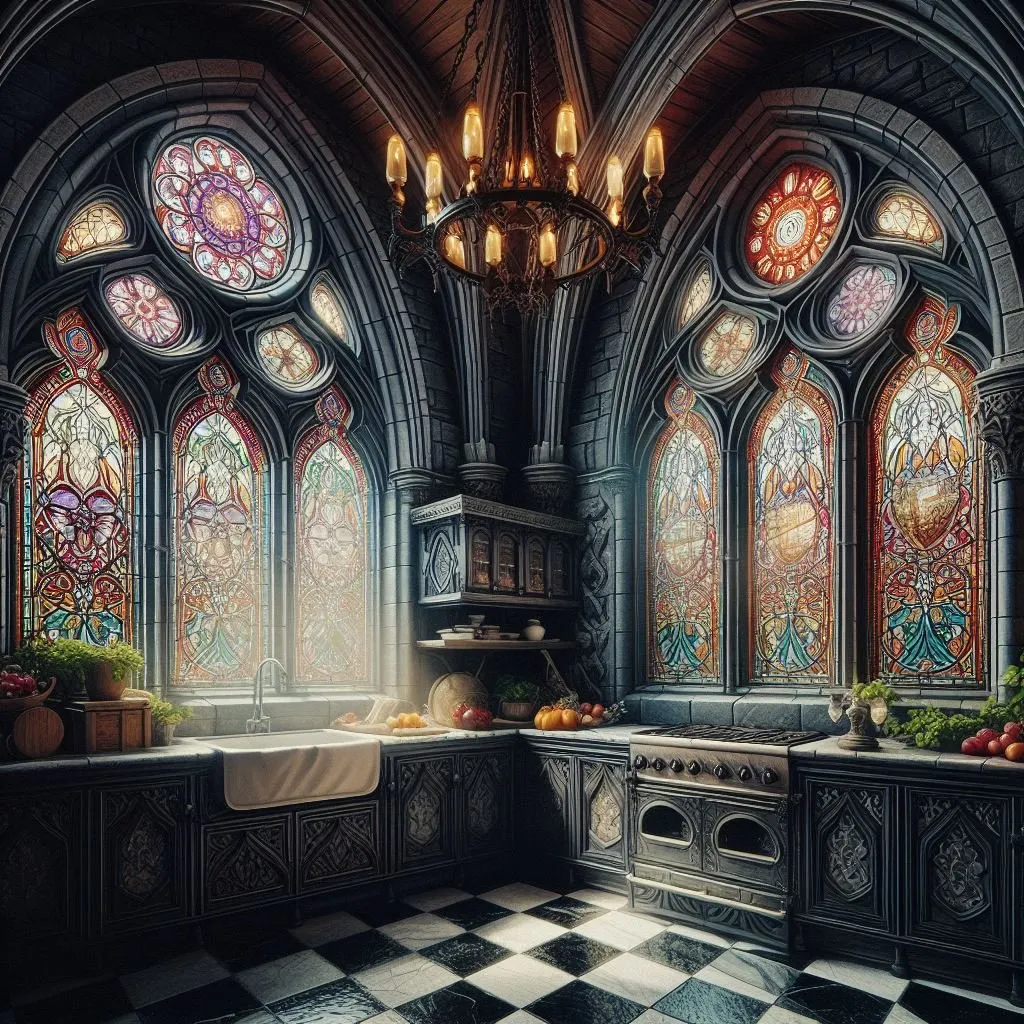
Monochromatic color schemes, using variations of a single color, offer a sophisticated and modern approach to Gothic kitchen design. This method involves using different shades, tones, and tints of one primary color to create depth and visual interest. A black monochromatic scheme can be particularly striking, using shades from charcoal to ebony to create a sense of drama and elegance. Similarly, dark grays or deep blues can provide a subtle yet captivating Gothic ambiance. The key to making this work is to vary textures and finishes. Matte, glossy, and textured surfaces of the same color can prevent the space from feeling flat. Consider adding metal accents in silver or bronze to contrast with the monochromatic palette. This approach creates a cohesive, visually stunning, and modern Gothic kitchen.
Gothic Kitchen Furniture and Fixtures
Furniture and fixtures are fundamental in establishing the Gothic style in a kitchen, creating a sense of historical elegance and dramatic flair. Key elements include ornate cabinetry, statement lighting, and carefully selected furniture pieces. Cabinets are often crafted from dark wood, such as mahogany or walnut, and feature intricate carvings and moldings. The hardware, such as handles and knobs, frequently incorporates wrought iron or antique finishes to enhance the gothic aesthetic. Statement lighting, which can include chandeliers, sconces, and pendants, should be chosen to create a dramatic effect. Furniture pieces, such as a kitchen island with gothic-inspired legs or a dining table with ornate details, further enhance the style. The integration of these elements creates a cohesive and immersive Gothic kitchen experience.
Ornate Cabinets and Drawers
Ornate cabinets and drawers are key to the Gothic kitchen aesthetic. Cabinets should have intricate carvings, moldings, and details that evoke the grandeur of the Gothic period. Dark woods like mahogany, walnut, or even stained oak provide a rich, historical look. Consider cabinets with arched doors, pointed arches, or paneled fronts to reflect Gothic architecture. Hardware, such as handles, knobs, and pulls, should be chosen to complement the cabinetry. Wrought iron, antique brass, or pewter finishes add character and enhance the aesthetic. The arrangement of the cabinets and drawers, including the layout and design, is equally important. The aim is to create a space that is both functional and visually stunning, seamlessly blending history and design to bring the space together.
Statement Lighting
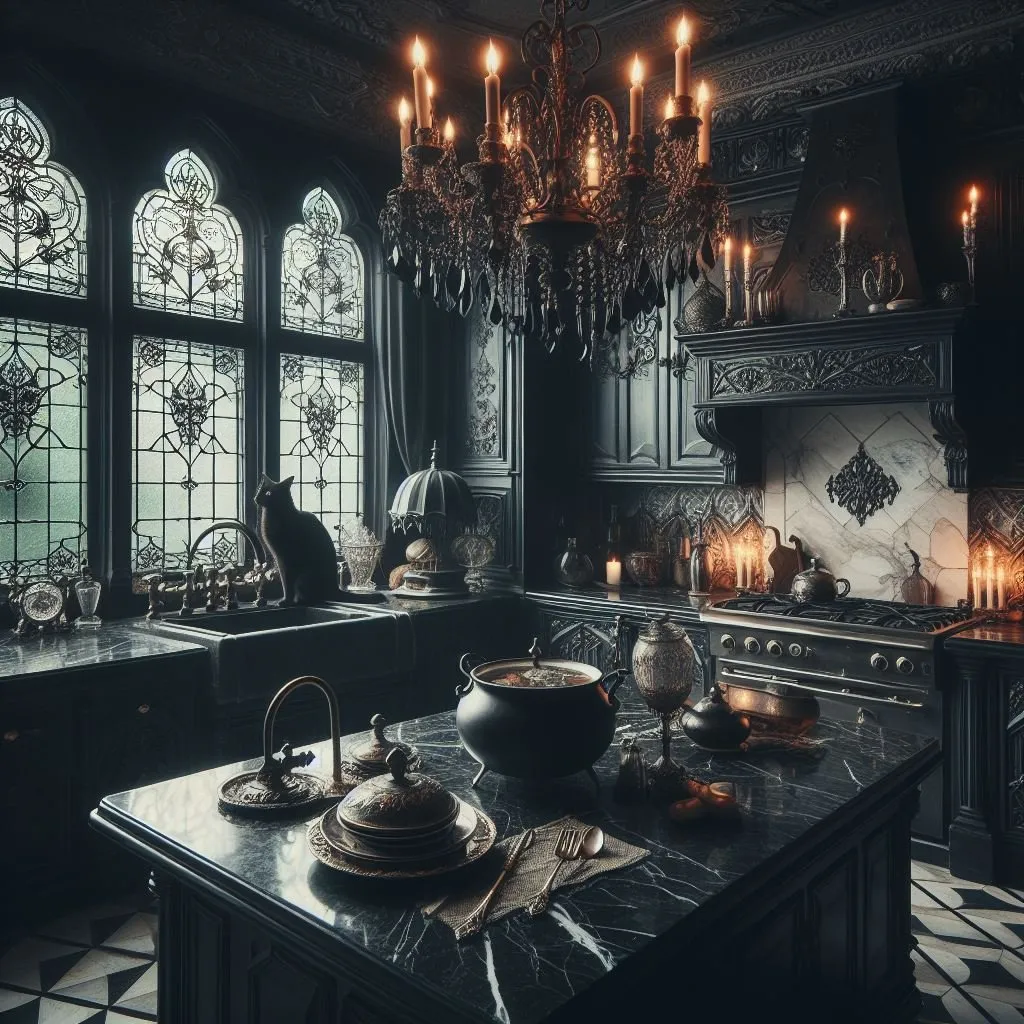
Statement lighting is a crucial element in a Gothic kitchen, creating a dramatic and atmospheric ambiance. Chandeliers, sconces, and pendant lights should be carefully chosen to enhance the Gothic aesthetic. Chandeliers, often made of wrought iron or featuring intricate crystal detailing, can serve as a focal point. Sconces, placed along the walls, can add a soft, ambient glow. Pendant lights, hung above the kitchen island or dining area, should be selected to complement the overall design. Consider lighting fixtures with dark metal finishes, antique detailing, or even candelabra-style designs to capture the Gothic spirit. The placement and type of lighting should be carefully considered to create both functional and aesthetically pleasing spaces. The interplay of light and shadow is critical, creating a sense of mystery and allure.
Gothic Kitchen Decor Accents
Decor accents play an essential role in defining a Gothic kitchen, adding personality, and enriching the overall aesthetic. Carefully selected accessories, such as candle holders, wall art, and textiles, bring a sense of depth and drama to the space. These elements are vital for conveying the essence of Gothic style. Antique mirrors with ornate frames can reflect light and expand the space, while wrought iron candle holders create a sense of intimacy and mystery. Gothic-inspired artwork, such as portraits or landscapes, can set a unique tone. Textiles, like velvet curtains or damask tablecloths, add texture and depth. Integrating these elements, enhances the immersive Gothic kitchen experience. The aim is to bring the space together.
Candle Holders and Candelabras
Candle holders and candelabras are essential accessories in a Gothic kitchen, adding to the atmospheric ambiance and reflecting the style’s dramatic character. The flickering light from candles enhances the sense of mystery and intimacy. Choose candle holders made from wrought iron, pewter, or antique brass to complement the other design elements. Candelabras, especially those with multiple arms and elaborate detailing, can serve as striking centerpieces on the kitchen island or dining table. Grouping candles of different sizes and heights creates visual interest and adds depth. Scented candles can create a pleasing aroma, further enhancing the sensory experience. The deliberate placement and selection of candle holders and candelabras contribute to the overall Gothic theme.
Gothic-Inspired Wall Art
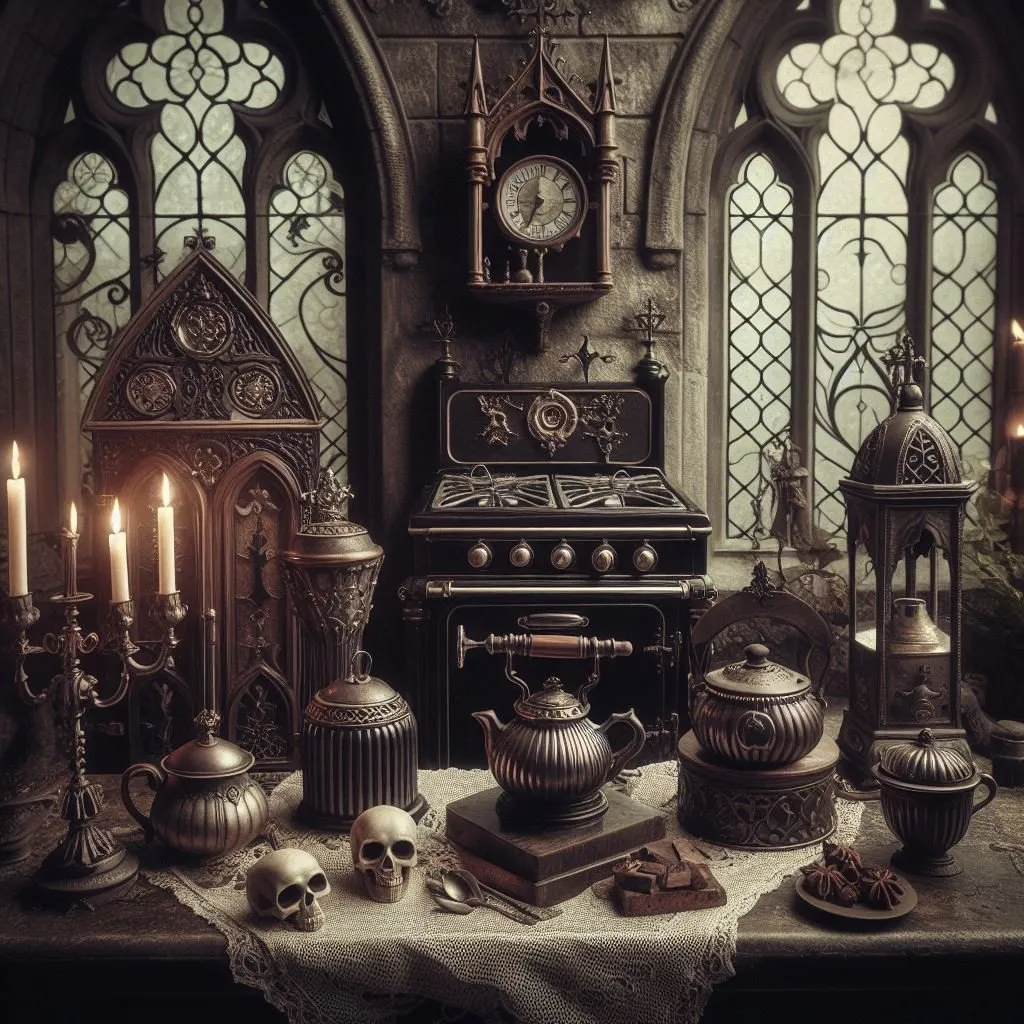
Gothic-inspired wall art enriches the visual narrative of a Gothic kitchen, adding personality and depth. Choose artwork that reflects the aesthetic of the Gothic period, such as portraits of historical figures, landscapes of brooding castles, or stylized representations of religious themes. Consider art with dark, rich colors and ornate frames. Mirrors with intricate, antique-style frames can also create visual interest and expand the space. The placement of the artwork is crucial, adding character and sophistication. By incorporating carefully selected Gothic-inspired wall art, you create a unique and immersive kitchen environment, reflecting an appreciation for history and design. Artwork can include a range of styles that align with the Gothic concept.
Incorporating Gothic Textiles
Incorporating Gothic textiles enhances the atmosphere in a kitchen, adding texture, depth, and richness to the space. Fabrics like velvet, brocade, and damask are ideal for creating a sense of luxury and drama. Consider using velvet curtains to frame windows, or add a damask tablecloth to the dining area. Upholstering chairs in rich, textured fabrics creates a cozy and inviting seating area. Textiles can also be used for decorative pillows, adding splashes of color and pattern. Pay attention to the texture of the fabrics, as this can enhance the overall aesthetic. The choice of colors and patterns should complement the existing color scheme. The use of textiles will bring all elements in the space together.
Textiles and Fabrics
Textiles and fabrics are vital in enhancing a Gothic kitchen’s aesthetic, adding texture, richness, and depth. Velvet, brocade, and damask are great choices for creating an opulent atmosphere. Consider velvet curtains or drapes to frame the windows, enriching the space with their plush texture and deep colors. A damask tablecloth on the dining table brings an element of classic elegance. Upholstering chairs with rich, textured fabrics enhances the space and improves the comfort. Decorative pillows in complementary patterns and colors add a touch of personality. The choice of fabrics and textiles should complement the existing color scheme and design. The right fabrics and textures will significantly contribute to the overall Gothic feel.
Textures and Patterns
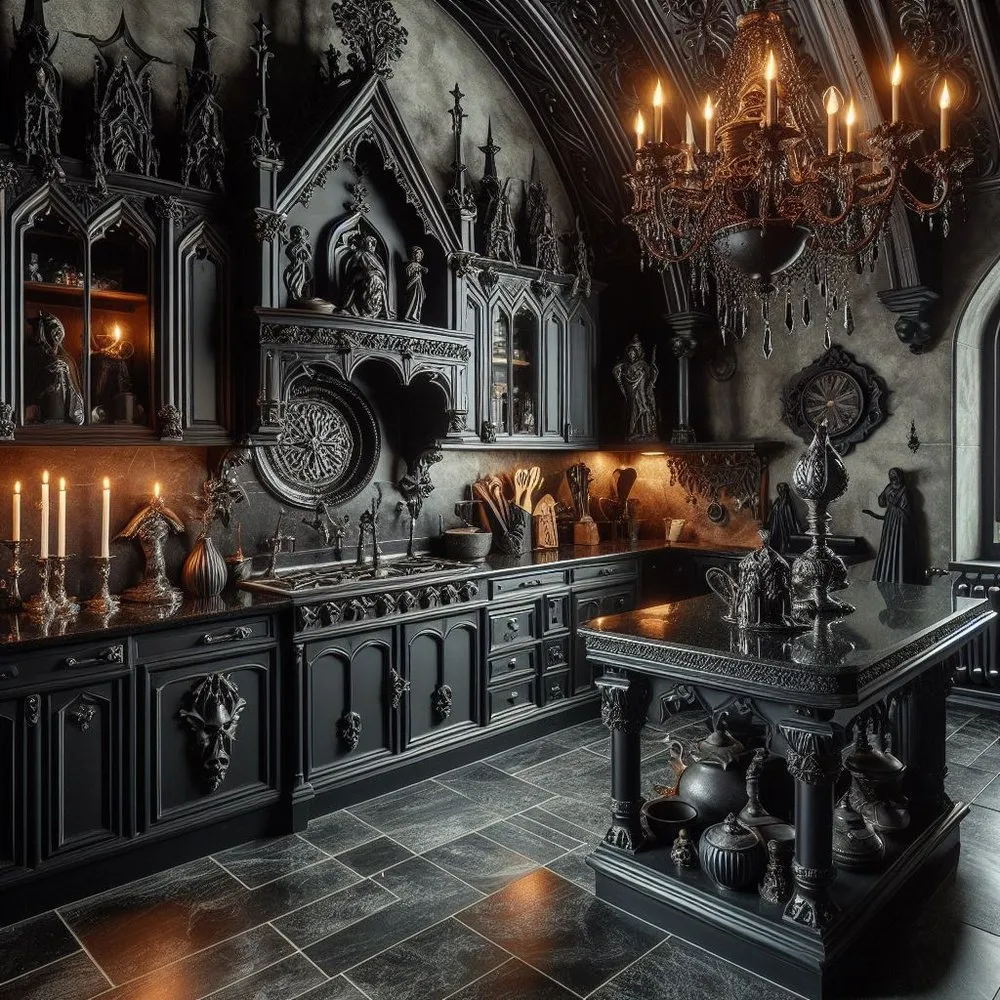
Textures and patterns in a Gothic kitchen enrich the visual and tactile experience, creating depth and complexity. Textures can be introduced through various materials, such as dark wood cabinets, stone countertops, and textured walls. Consider using patterned tiles or mosaics for backsplashes or flooring to add visual interest. Fabrics with intricate patterns, such as damask or brocade, can enhance the sense of luxury and sophistication. Mixing different textures and patterns creates a dynamic and visually appealing space. Using these elements creates depth and intrigue. The aim is to create a Gothic environment.
Modern Twists on Gothic Kitchens
Modern twists on Gothic kitchens blend the historical elegance of Gothic design with contemporary elements for a unique and stylish aesthetic. This approach merges the dramatic features of Gothic style, such as dark color palettes and ornate details, with the sleekness and functionality of modern design. The idea is to create a space that feels both timeless and up-to-date. Mixing traditional Gothic elements like dark wood cabinets and statement lighting with modern appliances and minimalist accessories is a smart strategy. Combining these elements results in a cohesive and visually captivating space.
Combining Gothic with Modern Elements
Combining Gothic and modern elements involves harmonizing historical details with contemporary design to create a unique kitchen space. Incorporate modern appliances and minimalist accessories into a Gothic kitchen. Use dark wood cabinets with sleek lines, coupled with modern hardware and countertops. A dramatic chandelier can be paired with recessed lighting to balance the lighting scheme. Pairing ornate details with streamlined designs can create a balance. Blending both elements results in a cohesive and aesthetically pleasing space. The result should be a kitchen that feels both timeless and current.
Gothic Kitchen Design: Top 7 Ideas
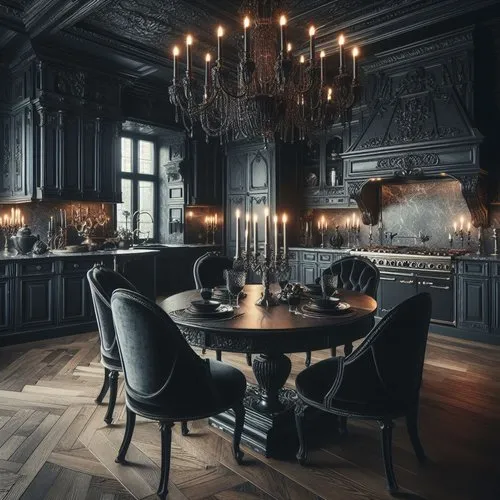
Here are 7 design ideas to help you transform your kitchen into a stunning Gothic space. These ideas encompass various aspects of design, from color schemes and furniture choices to lighting and accessories. Whether you are planning a complete renovation or looking for simple updates, these tips will help you create a captivating Gothic kitchen that reflects your personal style. Using these ideas can enhance the overall look.
Idea 1 Dark Wood Cabinets
Dark wood cabinets are central to Gothic kitchen design, adding depth and elegance. Choose woods like mahogany or walnut for their rich, deep tones and inherent beauty. Consider cabinets with intricate carvings, arched doors, and ornate hardware to enhance the aesthetic. This key element will enhance your kitchen’s Gothic feel, creating a space that is both functional and aesthetically pleasing. Dark wood cabinets set the tone for the entire kitchen.
Idea 2 Intricate Tile Work
Intricate tile work can elevate the Gothic kitchen design. Consider ornate tile patterns, mosaics, or dark-colored tiles to create a visually striking backdrop. Use these tiles for the backsplash, floor, or even a feature wall. This element adds depth and texture, creating a cohesive look. Incorporating intricate tile work is a great way to add an authentic Gothic feel to your kitchen.
Idea 3 Statement Lighting
Statement lighting plays a critical role in a Gothic kitchen. Choose chandeliers, sconces, and pendant lights to add drama and create an atmospheric ambiance. Chandeliers with wrought iron or crystal detailing can serve as the focal point. Sconces can add a soft glow, while pendant lights over the island enhance the design. Statement lighting enhances the Gothic look, adding both style and functionality.
Idea 4 Gothic Furniture
Gothic furniture can bring your kitchen to life. Choose a dining table with ornate details, a kitchen island with Gothic-inspired legs, or chairs with velvet upholstery. Antique or antique-style pieces add to the historical feel. Gothic furniture will add depth and personality. It is the perfect touch.
Idea 5 Metal Accents
Metal accents add a touch of elegance and create a balance in the gothic aesthetic. Consider hardware, faucets, and accessories in wrought iron, antique brass, or pewter finishes. These elements add detail and enhance the overall look. Incorporating metal accents adds a luxurious feel. It brings all of the elements in the space together.
Idea 6 Dramatic Color Scheme
A dramatic color scheme is key to the Gothic kitchen’s ambiance. Use a palette of deep reds, blacks, purples, and greens. Incorporating a dramatic color scheme is one of the most impactful ways to create a Gothic feel. Dark and rich tones can enhance the Gothic aesthetic and create a perfect atmosphere.
Idea 7 Gothic Kitchen Decor Accents
Decor accents can enhance the theme of your Gothic kitchen. Use candle holders, wall art, and textiles to bring a sense of depth and drama. These elements add character and create a unique space. Accents should add to the overall feel. Using them is a great way to add depth.
Maintaining and Caring for Your Gothic Kitchen
Maintaining a Gothic kitchen requires care to preserve its unique aesthetic. Regular cleaning and proper care will ensure that the materials and finishes retain their beauty and elegance. Proper maintenance protects the investment, keeping the space looking its best. Proper care and maintenance can help to keep the space looking fresh and enhance the overall experience.
Cleaning and Maintenance Tips
Cleaning and maintenance are essential to keep a Gothic kitchen in top condition. Use appropriate cleaning products for different materials, such as wood, metal, and tile. Dust and wipe down cabinets, fixtures, and surfaces regularly. Avoid abrasive cleaners that can damage finishes. Polish metal accents to maintain their shine. Regular cleaning helps prevent wear and tear. Following these tips can help maintain a beautiful Gothic kitchen.
Preserving the Gothic Aesthetic
Preserving the Gothic aesthetic involves ongoing care to ensure the kitchen’s unique character. Protect wood surfaces from moisture and heat with proper sealing and maintenance. Consider the environment and maintain the materials and finishes. Taking preventative steps helps preserve the overall look.
Conclusion
Gothic kitchen decor offers a unique and dramatic design aesthetic. From the origins of the style to the top design ideas, creating a Gothic kitchen is about embracing dark colors, ornate details, and atmospheric lighting. By incorporating these elements, you can transform your kitchen into a stunning space that reflects your personal style. A Gothic kitchen is an experience, not just a space. Create a space that is both functional and visually captivating, reflecting a profound appreciation for history and design. So, embrace the dark, the dramatic, and the mysterious, and create a Gothic kitchen that you will love.
